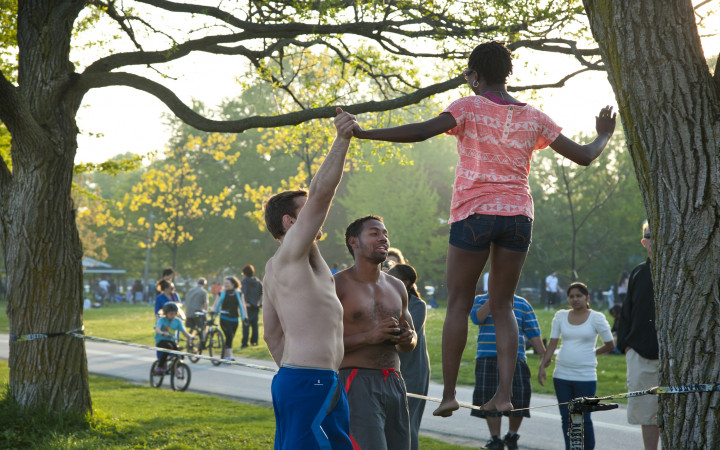Today’s Wonder of the Day was inspired by Makana. Makana Wonders, “How do tightrope walkers walk across the high wire without falling?” Thanks for WONDERing with us, Makana!
Are you a daredevil? When you first learned how to ride a bicycle, were you soon hopping curbs and flying off homemade ramps? Have you ever grabbed a skateboard and tried an ollie?
Maybe your idea of a thrill is even more radical. Do you dream of skydiving out of an airplane one day? How about climbing Mt. Everest? Maybe you've thought about walking a tightrope across the Grand Canyon?
If the idea of walking on a tightrope high in the air piques your interest, then we've got a sport that you might love: slacklining. At first glance, slacklining might look a bit like tightrope walking, but it's actually a unique sport all its own.
Some slackliners consider slacklining as much an art as a sport. They believe it can be summed up as a mixture of balance training, recreation, and meditation.
Slacklining involves stretching a soft, stretchy strap about one to two inches wide (known as "webbing") between two anchor points, which are usually trees. The line might be only a few feet off the ground, or it could be thousands of feet in the air across a canyon.
The key to walking a slackline is balance and control. Unlike a tightrope, the tension on a slackline can be adjusted to create a variety of situations. For example, the dynamic, bouncy, stretchy webbing can be used for trampoline-like tricks, performing yoga, or walking long distances.
Experts believe slacklining got its start within the rock climbing community at Yosemite National Park in the 1980s. Climbers rigged slacklines to help improve concentration, core strength, and balance between climbs.
Today, there are a wide variety of different types of slacklining. A waterline, for example, is any slackline rigged over water. While this increases safety, since falling into water causes few injuries, it's more difficult than many people realize because the movement of water below the line makes it more difficult to control balance.
The type of slacklining that gets the most attention is highlining, which involves rigging a slackline thousands of feet above the ground. This type of slacklining might be done between adjacent mountain peaks or across a deep valley.
The potential for danger in highlining is quite high, but the practice has maintained a relatively strong safety record thanks to the use of tethers, safety harnesses, and advanced rigging equipment with backup systems.




